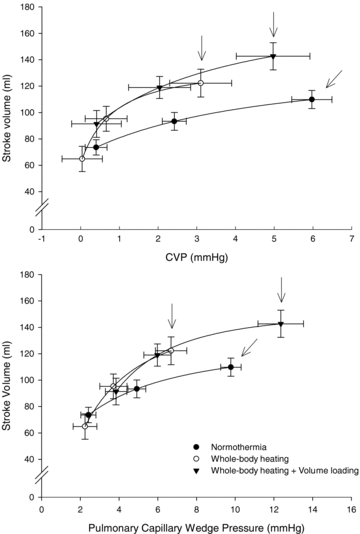Effect of volume loading on the Frank-Starling relation during reductions in central blood volume in heat-stressed humans
- PMID: 20603336
- PMCID: PMC2976026
- DOI: 10.1113/jphysiol.2010.191981
Effect of volume loading on the Frank-Starling relation during reductions in central blood volume in heat-stressed humans
Abstract
During reductions in central blood volume while heat stressed, a greater decrease in stroke volume (SV) for a similar decrease in ventricular filling pressure, compared to normothermia, suggests that the heart is operating on a steeper portion of a Frank-Starling curve. If so, volume loading of heat-stressed individuals would shift the operating point to a flatter portion of the heat stress Frank-Starling curve thereby attenuating the reduction in SV during subsequent decreases in central blood volume. To investigate this hypothesis, right heart catheterization was performed in eight males from whom pulmonary capillary wedge pressure (PCWP), central venous pressure and SV (via thermodilution) were obtained while central blood volume was reduced via lower-body negative pressure (LBNP) during normothermia, whole-body heating (increase in blood temperature 1 degrees C), and during whole-body heating after intravascular volume expansion. Volume expansion was accomplished by administration of a combination of a synthetic colloid (HES 130/0.4, Voluven) and saline. Before LBNP, SV was not affected by heating (122 +/- 30 ml; mean +/- s.d.) compared to normothermia (110 +/- 20 ml; P = 0.06). However, subsequent volume loading increased SV to 143 +/- 29 ml (P = 0.003). LBNP provoked a larger decrease in SV relative to the decrease in PCWP during heating (8.6 +/- 1.9 ml mmHg(1)) compared to normothermia (4.5 +/- 3.0 ml mmHg(1), P = 0.02). After volume loading while heat stressed, the reduction in the SV to PCWP ratio during LBNP was comparable to that observed during normothermia (4.8 +/- 2.3 ml mmHg(1); P = 0.78). These data support the hypothesis that a Frank-Starling mechanism contributes to compromised blood pressure control during simulated haemorrhage in heat-stressed individuals, and extend those findings by showing that volume infusion corrects this deficit by shifting the operating point to a flatter portion of the heat stress Frank-Starling curve.
Figures

Comment in
-
Hot and heavy volume loading in the heat-stressed, haemorrhagic male: modulating the Frank-Starling curve.J Physiol. 2011 Feb 15;589(Pt 4):777-8. doi: 10.1113/jphysiol.2010.202945. J Physiol. 2011. PMID: 21486845 Free PMC article. Review. No abstract available.
References
-
- Bundgaard-Nielsen M, Sorensen H, Dalsgaard M, Rasmussen P, Secher NH. Relationship between stroke volume, cardiac output and filling of the heart during tilt. Acta Anaesthesiol Scand. 2009;53:1314–1328. - PubMed
-
- Cai Y, Holm S, Jenstrup M, Stromstad M, Eigtved A, Warberg J, Hojgaard L, Friberg L, Secher NH. Electrical admittance for filling of the heart during lower body negative pressure in humans. J Appl Physiol. 2000;89:1569–1576. - PubMed
-
- Cooke WH, Ryan KL, Convertino VA. Lower body negative pressure as a model to study progression to acute hemorrhagic shock in humans. J Appl Physiol. 2004;96:1249–1261. - PubMed
Publication types
MeSH terms
Substances
Grants and funding
LinkOut - more resources
Full Text Sources

